Seahawks Analysis: Best/Worst-Case Scenarios For 2023 Draft Class
In the midst of organized team activities and quickly closing in on their first training camp in the NFL, the Seattle Seahawks have high expectations for their latest 10-player draft class heading into the 2023 season.
Headlined by a pair of first-round picks in cornerback Devon Witherspoon and receiver Jaxon Smith-Njigba, Seattle hopes to have struck gold again after last year's crop of rookies played a starring role in leading the franchise back to the playoffs. With plenty of starting jobs up for grabs, including center and right guard, opportunities will be present for this year's group to make a similar impact right away.
Analyzing the class as a whole, what are realistic expectations for Witherspoon and company entering their rookie seasons with the Seahawks? And what would ceiling and floors look like for each player in year one?
Considering playing time, skill set, and scheme fit among other factors, here are best and worst case scenarios for each of Seattle's 10 draft picks in 2023.
CB Devon Witherspoon
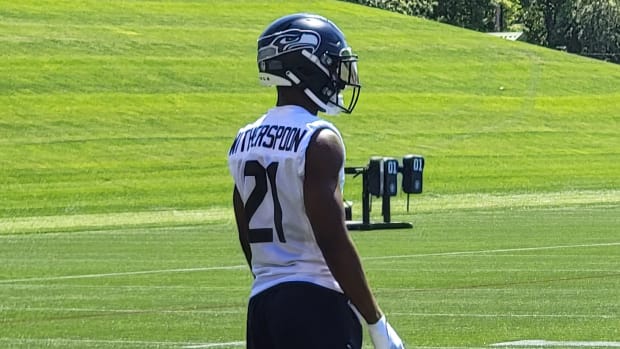
Best Case: Continuing a recent trend of dominant play right away by cornerbacks drafted in the first five picks, Witherspoon quickly wins the starting job on the left side across from Tariq Woolen and thrives. With his physical play and plus-ball skills translating well to the NFL under the coaching of Pete Carroll, Karl Scott, and company, he holds opposing quarterbacks under a 55 percent completion percentage and yields only two touchdowns in coverage. Racking up 64 tackles, four interceptions, and two forced fumbles while also scoring a defensive touchdown, earning himself a Pro Bowl nod and capturing Defensive Rookie of the Year honors in similar fashion to Woolen last year.
Worst Case: Unable to play the role of enforcer on the outside as he did at Illinois weighing under 185 pounds, Witherspoon struggles to finish tackles out of the gate and after getting beat on a pair of double moves for explosive plays early in the season, he receives a benching in favor of Mike Jackson. He eventually returns to the lineup with renewed confidence and finishes on a strong note, but his rookie campaign ends with only one interception and questions about whether or not he physically can perform up to the lofty standards of a top-five pick as hoped.
WR Jaxon Smith-Njigba
Best Case: Showing no ill effects from the hamstring injury that derailed his final season at Ohio State, Smith-Njigba carves up Seattle's cornerbacks during training camp and puts on a clinic in the preseason, securing a major role on offense complementing DK Metcalf and Tyler Lockett. Becoming a favorite go-to target for Geno Smith in the intermediate passing game and providing much-needed punch after the catch, he snags 65 receptions for 725 yards and finds the end zone six times, making one of the NFL's best passing attacks even more lethal and garnering PFWA All-Rookie Team honors.
Worst Case: Despite being fully recovered from his injury, with Metcalf and Lockett receiving the lion's share of targets from Smith and a quality tight end group also receiving plenty of touches, there's only so many opportunities left for Smith-Njigba to make an impact. While he gradually increases his production as the year progresses and finishes with over 350 yards and a trio of touchdowns, his presence does more to help Metcalf and Lockett continue putting up gaudy numbers than generate impressive individual stats expected of a first-round pick at the position.
LB Derick Hall
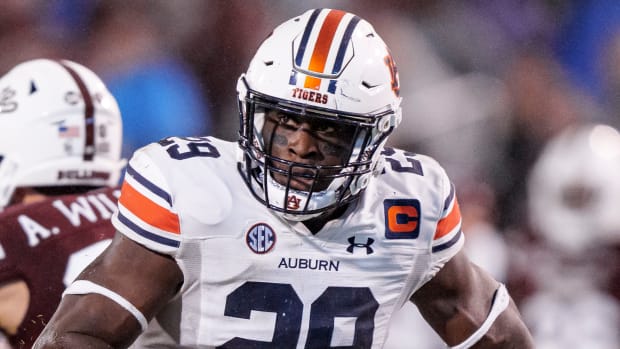
Best Case: Overpowering opposing tackles throughout the preseason with bullying bull rushes and long arm moves while holding his own as an edge setter defending the run, the gritty Hall gives Uchenna Nwosu a run for his money rotating on the right side, earning a substantial rotational role at the start of the season. Emerging as a playmaking factor early on and chasing down plays all over the field with infectious effort, he produces 6.5 sacks and nine tackles for loss in his first season as a Seahawk, looking the part of a future starter and a day two steal with an improved pass rushing palette featuring developing counters.
Worst Case: Without an established go-to counter to work off of his speed-to-power moves, Hall gets off to a sluggish start in the pass rushing department and his aggressive nature backfires on him with run gap responsibilities, leading to a limited role in the first quarter of the season. Getting more comfortable as the year progresses, he settles into a reserve spot behind Nwosu, but he doesn't provide the instant juice Seattle hopes for with only 2.5 sacks and eight quarterback hits.
RB Zach Charbonnet
Best Case: Looking like the second coming of Marshawn Lynch, Charbonnet shines right away as a change of pace battering ram in tandem with Ken Walker III, carving out a 50/50 time share in the backfield running through the teeth of opposing defenses early in his rookie year. Racking up yards after contact in bunches and stealing goal line reps to vulture touchdowns in the first two months, he eventually becomes Seattle's primary workhorse in the second half of the season thanks to his bruising style and underrated hands out of the backfield, finishing the year with over 800 rushing yards and eight combined scores.
Worst Case: Though talented and capable, Charbonnet can't stack up with Walker's burst and overall athleticism, leaving him second fiddle in Seattle's backfield pecking order. Aside from being utilized as a short-yardage back and rotating in for a handful of possessions per game, he fails to earn a defined role on offense, including missing out on third down reps to DeeJay Dallas and fellow rookie Kenny McIntosh. Relegated to special teams duty with a couple of spot starts, he wraps up the season with under 500 yards rushing and only two touchdowns, creating questions about using a second-round pick on him with Walker already on the roster.
OG Anthony Bradford
Best Case: Knocking defenders off the ball and displaying the elite athletic traits he flashed at the combine as a run blocker, Bradford puts veteran Phil Haynes on notice early in his first training camp and joins Damien Lewis as the latest LSU guard to earn a day-one starting job in Seattle. Instantly bringing much-needed physicality to the middle of the offensive line, his presence helps Walker and Charbonnet explode for 2,000 combined rushing yards and pace a top-five rushing attack. Though he gives up three sacks, he makes noticeable strides in pass protection as the year progresses, looking like a long-term starter.
Worst Case: With his lack of starting experience at the college level rearing its ugly head, Bradford looks overwhelmed facing NFL competition during the preseason, particularly struggling in pass protection against athletic interior rushers. Seizing his opportunity to finally start, Haynes performs at a high level and the Seahawks extend him along with re-signing Lewis during the offseason, blocking the fourth-round pick's path to a starting spot moving forward.
DT Cameron Young
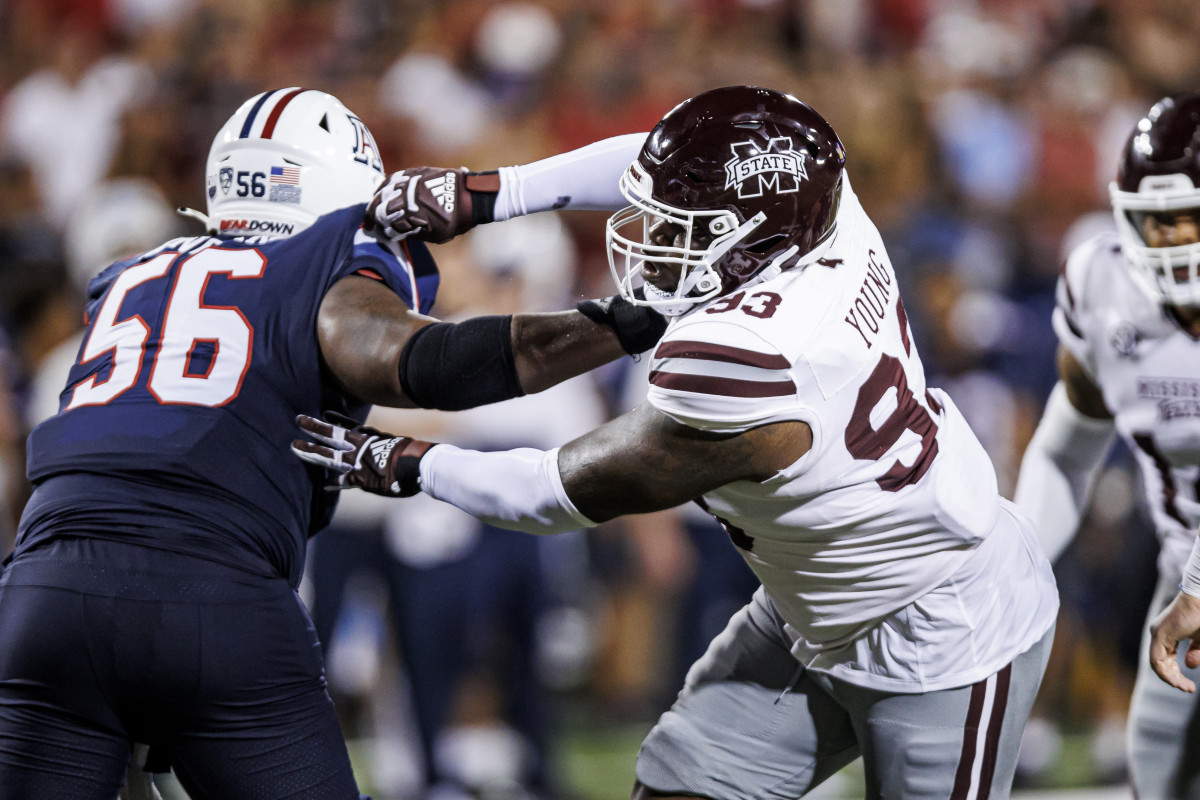
Best Case: Benefiting from playing a more traditional nose tackle role than he did in Mississippi State's slant-heavy scheme, Young instantly becomes a space-stuffing stalwart in the middle of Seattle's defense. With him proving to be difficult to move off the line of scrimmage against single and double blocks, Bobby Wagner and the rest of the linebackers feast with clean avenues to make plays against the run. Meanwhile, Young surprises with 15 quarterback pressures, flashing more pass rushing chops than he did at the college level in a different system catered better to his strengths.
Worst Case: Thrust into an unenviable situation filling huge shoes left behind by Al Woods, Young gets pushed around early in the season as the Seahawks get blitzed by opposing run games amid a rough start. He also fails to contribute much as a pass rusher, leading to fewer overall snaps by week. Once Bryan Mone returns to action by midseason from a torn ACL, he takes over as the starter and the rookie falls into a further diminished backup role in the second half, casting doubt about his viability as a future starter in the trenches.
DE Mike Morris
Best Case: At his best at a beefed up 295 pounds playing inside, Morris impresses throughout training camp and preseason, holding his own as a run defender and bringing electricity to Seattle's interior pass rush. After opening the year in a reserve role behind Jarran Reed, he eventually surpasses the veteran in the final eight games due to stellar play and emerges as a capable starter, finishing his rookie season with four sacks, seven tackles for loss, and a healthy 12 percent pressure rate. Just scratching the surface of his potential, the Seahawks appear to have hit the jackpot on day three.
Worst Case: After primarily playing off the edge in his final season at Michigan, Morris endures significant growing pains adjusting to the 3-tech defensive end role. Though he looks the part, struggles with leverage at 6'6 crop up throughout camp and exhibition season and while he earns a spot on the final roster, he sees only a handful of snaps per game for most of the year in what amounts to a redshirt season for the fifth-round pick.
C Olu Oluwatimi
Best Case: Highly decorated coming out of Michigan, Oluwatimi promptly shows why he captured the Rimington and Outland Awards as a senior, wasting little time passing veteran Evan Brown on the depth chart and securing a starting job early in training camp. In full command of the huddle, he immediately handles his responsibilities making line calls in the pass and run game, displaying the savvy of a 10-year veteran after playing over 3,500 snaps at center in college. Making other teams look silly for allowing him to last all the way to the fifth-round in the process, the Seahawks finally find their long-term answer at the pivot position.
Worst Case: While Oluwatimi hangs tough in the competition against Brown, the veteran outplays him in the preseason with better consistency in the run game, earning the starting job in Week 1. Making the most of his chance on a one-year prove it deal, Brown maintains the starting job for the entire season and the Seahawks opt to re-sign him to a multi-year deal next March, putting Oluwatimi in a similar situation to Bradford without a starting spot available for him in 2024 and beyond.
S Jerrick Reed II
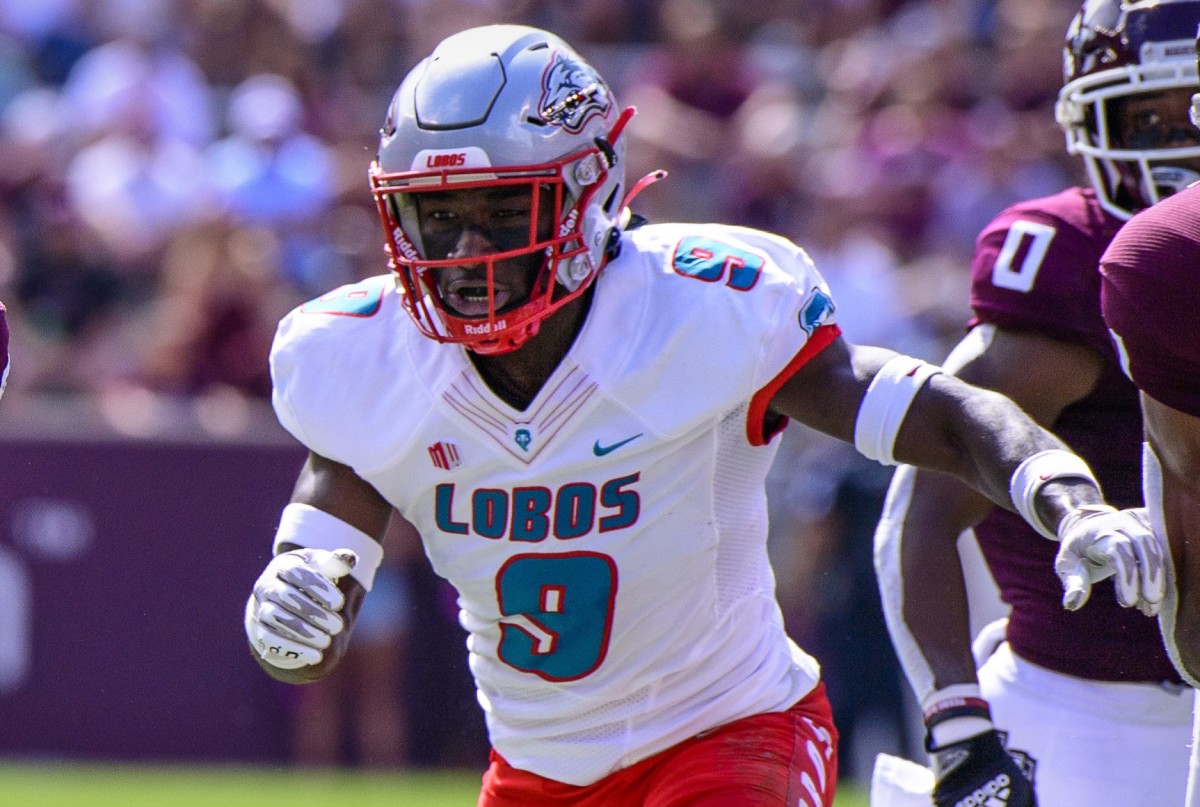
Best Case: Flying all over the practice field making plays at both safety positions as well as in the nickel, Reed's athleticism and versatility catch the attention of Carroll and his staff, earning him a situational sub-package role as a rookie. Making a handful of tackles on defense and shining as a core special teams player on kick and punt coverage units, the ex-New Mexico standout rewards Seattle for its faith in him as an under-the-radar prospect with a strong rookie season and positions himself to potentially be an heir apparent for Quandre Diggs or Jamal Adams in the next year or two.
Worst Case: Playing in a crowded, talented safety group, Reed gets overshadowed by newcomer Julian Love and returning second-year defender Joey Blount during camp. With limited chances to impress on defense and the return of a healthy Adams, the Seahawks don't have room for him on the initial 53-man roster and they release him in favor of Blount, eventually re-signing the sixth-round pick to the practice squad for further development.
RB Kenny McIntosh
Best Case: Carrying a massive chip on his shoulder after somehow falling to the seventh round, McIntosh immediately makes his mark as a duel threat third-down back, surpassing Dallas for the role in the early stages of camp. Snagging several passes out of the backfield in two-minute offense situations and producing with limited opportunities as a runner, he pushes Walker and Charbonnet for snaps by the second half, giving the Seahawks one of the best trios of backs in the league with all three players under contract for at least the next three seasons together. In addition, he pitches in a couple of tackles and steps up as a punt returner on special teams.
Worst Case: On the small side under 205 pounds with average athleticism, McIntosh gets lost in the shuffle behind Walker, Charbonnet, and Dallas in August. Thanks to his special teams contributions and pass-catching ability, he maintains a roster spot out of camp, but he finds himself as the odd man out on game day with the Seahawks making him inactive as a healthy scratch for several regular season games. While he catches 12 passes, he rushes for under 100 yards in a limited offensive role as a rookie.
Want the latest in breaking news and insider information on the Seahawks? Click Here to subscribe to AllSeahawks.com's Newsletter.
Follow All Seahawks.com on Twitter and Facebook
Make sure to subscribe to our daily podcast @lockedonseahawks today! Click here To Listen.
Want even more Seattle Seahawks news? Check out the SI.com team page here.
